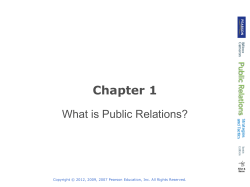
Chapter 1 Chemistry: A Science for All Seasons
Chapter 1 Chemistry: A Science for All Seasons Copyright © 2010 Pearson Education, Inc. A key aspect of a scientific hypothesis is that it must be: a. b. c. d. e. Creative Unique Testable Persuasive Understandable Copyright © 2010 Pearson Education, Inc. A key aspect of a scientific hypothesis is that it must be: a. b. c. d. e. Creative Unique Testable Persuasive Understandable Copyright © 2010 Pearson Education, Inc. Which of the following processes represents a chemical change? a. Water freezes into ice. b. Water evaporates. c. Butter melts in a hot pan. d. A bicycle left outdoors begins to rust. e. Sugar dissolves in hot coffee. Copyright © 2010 Pearson Education, Inc. Which of the following processes represents a chemical change? a. b. c. d. Water freezes into ice. Water evaporates. Butter melts in a hot pan. A bicycle left outdoors begins to rust. e. Sugar dissolves in hot coffee. Copyright © 2010 Pearson Education, Inc. What quantity represents the smallest mass? a. b. c. d. e. Copyright © 2010 Pearson Education, Inc. 0.01 kg (10g) 1.0 g 100 mg (0.1g) 1000 µg µ (10-3g) 100,000 ng (10-4g) What quantity represents the smallest mass? a. b. c. d. e. 0.01 kg (10g) 1.0 g 100 mg (0.1g) 1000 µg µ (10-3g) 100,000 ng (10-4g) Copyright © 2010 Pearson Education, Inc. A 10.0-g sample of which of the following substances would have the greatest volume? a. b. c. d. e. Hexane (0.660 g/mL) Ethyl alcohol (0.789 g/mL) Water (1.00 g/mL) Magnesium (1.738 g/cm3) Copper (8.94 g/cm3) Copyright © 2010 Pearson Education, Inc. A 10.0-g sample of which of the following substances would have the greatest volume? a. b. c. d. e. Hexane (0.660 g/mL) Ethyl alcohol (0.789 g/mL) Water (1.00 g/mL) Magnesium (1.738 g/cm3) Copper (8.94 g/cm3) Copyright © 2010 Pearson Education, Inc. The energy required to heat 1.0 L of water from room temperature (20 ºC) to boiling is: a. b. c. d. e. Copyright © 2010 Pearson Education, Inc. 80 calories 80 kilocalories 800 calories 800 kilocalories 8000 calories The energy required to heat 1.0 L of water from room temperature (20 ºC) to boiling is: a. b. c. d. e. 80 calories 80 kilocalories 800 calories 800 kilocalories 8000 calories Why? 1.0 L =1000 mL = 1000 g H2O Boiling water is 100 ºC, so temp increase is 80 ºC x 1000 g = 80,000 cal or 80 kcal. Copyright © 2010 Pearson Education, Inc. Which of the following claims are falsifiable? a. A classmate claims that carrying an amethyst will increase your mental alertness if you are open to its positive energy. b. Your fellow student claims to have memorized all of the elemental names and symbols on the periodic table. c. A self-help guru claims that if your desire for success is strong enough, you will receive it. d. An alternative health practitioner claims that drinking “energized water” will promote cell health and increase moisture absorption by your body, resulting in increased vitality and overall energy. Copyright © 2010 Pearson Education, Inc. Which of the following claims are falsifiable? a. A classmate claims that carrying an amethyst will increase your mental alertness if you are open to its positive energy. b. Your fellow student claims to have memorized all of the elemental names and symbols on the periodic table. c. A self-help guru claims that if your desire for success is strong enough, you will receive it. d. An alternative health practitioner claims that drinking “energized water” will promote cell health and increase moisture absorption by your body, resulting in increased vitality and overall energy. Copyright © 2010 Pearson Education, Inc.
© Copyright 2025





















